By now, most of us have heard from numerous health authorities that green tea and dark chocolate have many healthy properties. These two "superfoods" are packed with anti-inflammatory antioxidants that can improve metabolic health, prevent weight gain, and even protect the cardiovascular system from injury.
The reason we're bringing these two up together is they both have high concentrations of epicatechin, a special antioxidant that's responsible for most, but not all, of their health benefits.
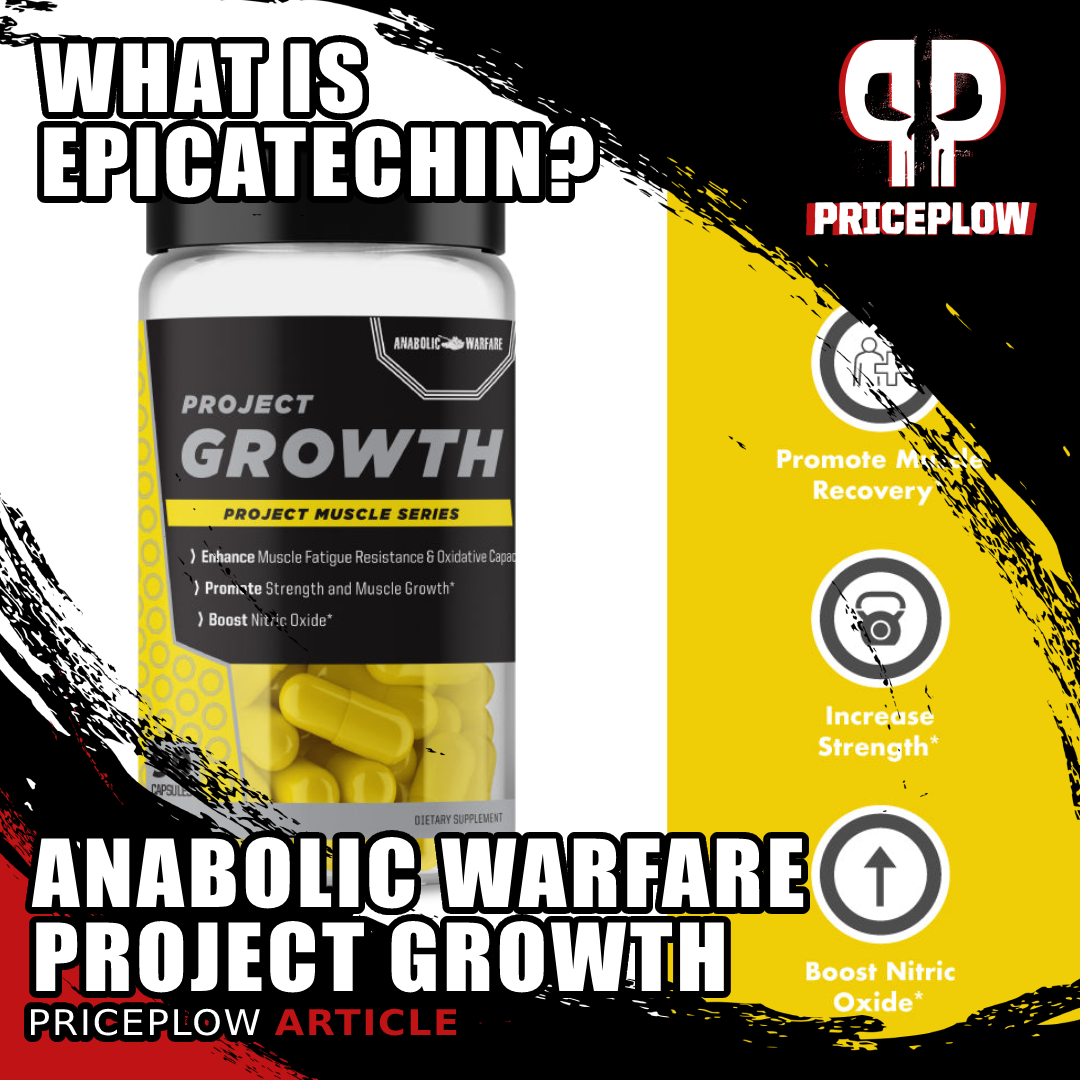
With this article about Anabolic Warfare Project Growth, we take an updated look at key ingredient epicatechin
Anabolic Warfare’s Project Growth – Epicatechin
That brings us to Project Growth from Anabolic Warfare, part of their ongoing Project Muscle series.
A quick glance at the label shows us there are just two ingredients in this product: epicatechin accounts for the vast majority of it by weight, along with a supporting dose of green tea extract.
Many readers may be surprised to see polyphenol antioxidants marketed as an anabolic supplement. Most of what's written on the subject of polyphenols focuses overwhelmingly on their metabolic and cardiovascular benefits, with much less being said about their impact on processes like muscle protein synthesis.
But as we have often written on the PricePlow Blog, processes like MPS are downstream from cellular metabolic function. So it's not totally surprising that a supplement intended to optimize cellular metabolism could have the indirect effect of maximizing muscle growth.
Don't worry, we'll get deep in the weeds on this. But first, let's check the PricePlow news and deals:
Anabolic Warfare Project Growth – Deals and Price Drop Alerts
Get Price Alerts
No spam, no scams.
Disclosure: PricePlow relies on pricing from stores with which we have a business relationship. We work hard to keep pricing current, but you may find a better offer.
Posts are sponsored in part by the retailers and/or brands listed on this page.
This area is reserved for Team PricePlow's upcoming Ingredients video.
Subscribe to our channel and sign up for notifications so you catch it when it goes live!
Epicatechin: background
Foods like cocoa and green tea have been identified as rich sources of flavonoids and flavonols, which are defined as flavonoids with a ketone group attached.
Compared to ordinary flavonoids, flavonols seem to be uniquely beneficial when it comes to improving health, wellness, and performance. And of the many flavonols found in cocoa beans,[1] epicatechin seems to be the most beneficial.[2]
The formal name of "epicatechin" is actually (-)-epicatechin, which we read as "minus epicatechin." This form of epicatechin is the one naturally abundant in familiar foods like dark chocolate and tea, and is marketed as a nutritional supplement.
In Anabolic Warfare's Project Growth, we have a 1,000-milligram dose of epicatechin extract with a 10% standardization, which should yield about 100 milligrams of pure epicatechin. Just to put that number in context, there's somewhere between 1.5 to 2.5 milligrams of epicatechin in every gram of cocoa.[1,3]
So to get 100 milligrams of pure epicatechin from cocoa beans as a whole food, we'd have to consume about 50 grams of cocoa.
If you ate a standard-sized 70% dark chocolate bar weighing about 200 grams, you'd get approximately 280 milligrams of epicatechin - so long as the cocoa is not processed with alkali (alkalized), which destroys much of the flavonol content.[4-6]
So with a single 2-capsule serving of Project Growth from Anabolic Warfare, you're getting about a third of the epicatechin you'd get from a full dark chocolate bar.
That might not sound too impressive, but consider the fact that you're getting the most powerful bioactive constituent of the chocolate without adding any calories to your daily intake - and we're still getting other beneficial flavonoids from the green tea extract. That makes it a powerful tool for bodybuilders, athletes, and anyone who aspires to change their body composition through calorie and macronutrient manipulation.
Concentrations of epicatechin in other foods
Cocoa and tea are not the only sources of epicatechin. You can also obtain epicatechin from the following sources, in the following amounts:
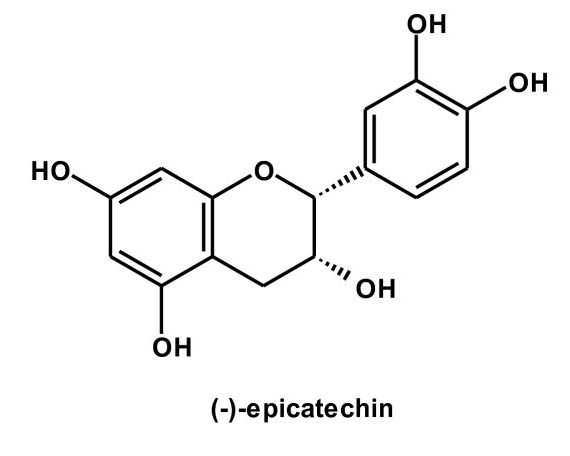
Epicatechin's structure looks similar to other known catechins like the popular EGCG from green tea, but it has a whole new batch of benefits and properties
- Blueberries (0.6 mg per gram)[7]
- Ginger (0.56 mg per 1 gram)[8]
- Fava beans (0.23 mg per 1 gram)[9]
- Blackberries (0.11 mg per 1 gram)[9]
- Apple cider (.09 mg per 1 mL)[9]
- Apples (.083 mg per 1 gram)[9]
- Green and black tea (.04 mg per 1 mL)[9]
- Red wine (.038 mg per 1 mL)[9]
- Chinese hawthorn berries (1.4 mg per 1 g)[10]
Astute readers who've paid attention to trends in nutrition and biochemistry can probably recognize all the foods and beverages on this list as popular superfoods. While Chinese hawthorn berries have the greatest known concentration, they're also less common in Western supermarkets, so we put them at the end of the list.
Whenever a bunch of different highly beneficial foods turn out to have a common denominator, we should pay close attention: in this case, one important commonality is epicatechin.
Epicatechin: benefits
When taken in efficacious doses, which we'll define precisely in our later discussion of the research literature, epicatechin can:
- Improve circulation and increase nitric oxide (NO) production
- Improve insulin sensitivity
- Reduce blood cholesterol levels
- Reduce blood pressure
- Increase skin elasticity
- Promote muscle growth by inhibiting myostatin
Let's go through each of these in detail.
-
Nitric Oxide Upregulation
Nitric oxide (NO) is a frequent subject of discussion on the PricePlow Blog, owing to its central importance for optimal cardiovascular function.
You can think of a NO as a messenger molecule that tells your blood vessels to relax and dilate, which ultimately allows for greater blood flow and improved circulation. The technical name for the dilation of these blood vessels is vasodilation.
There are several reasons why you'd want to upregulate vasodilation. For one thing, it reduces blood pressure.[11] It also can improve athletic performance[12] by optimizing the delivery of oxygen and nutrients to your muscle cells.
Nitric oxide benefits cardiovascular health
Reduced NO bioavailability, and reduced NO production, are both related to the onset of cardiovascular disease.[13,14]
That's because NO is broadly cardioprotective, and plays a crucial role in defending the cardiovascular system from the stress and damage incurred by normal metabolic function.[15] NO does this by a variety of seemingly unrelated mechanisms, including mitochondrial optimization, which is always a good thing.[15]
The more epicatechin given to these mice, the more incredible their nitric oxide parameters - even without exercise.[16] This source goes on to show other charts, such as mitochondrial protein and tension strength, all with similarly impressive results.
Although NO can definitely improve athletic performance and recovery, and even cognitive function, we also should care about our long-term cardiovascular health. To age well and help discourage the onset of age-related cardiovascular disease, compounds like epicatechin are indispensable.
Although studies on the correlation between CVD and epicatechin specifically are somewhat lacking, research consistently finds a negative correlation between CVD and intake of epicatechin-rich foods like tea[17] and cocoa.[18]
Looking over the list of foods above, it's hard to argue that any one of them shouldn't be considered for inclusion as part of a well-designed anti-aging diet.
How epicatechin upregulates NO: arginase inhibition
In one study, subjects consumed 30 grams of 70% dark chocolate daily. At the end of the two-week study period, they were found to have 54% more NO in their blood.[19] As a control, the researchers gave another group white chocolate, which isn't exactly chocolate and is devoid of epicatechin. The researchers found that the white chocolate group showed no change in NO production,[19] leaving us to deduce that one of dark chocolate's polyphenols -- perhaps epicatechin -- was responsible for the NO-boosting property.
The researchers of that study discuss how epicatechin is at least partially to credit for the increase in nitric oxide production:
Vasodilatative effects of cocoa was obtained by its capability to supress arginase enzyme activity which will lose in the competition with NO endothelial synthase. This in turn will increase the production of NO.[20] The other mechanism of cocoa on vasodilatation is associated with increased epicatechin levels in plasma which will give a signal to release vasoactive components from endothelial cells, i.e., NO and prostacyclin.[21] This process will also decrease ratio leukotriene-prostacyclin to cause vasodilatative effect.[20]
-- Sudarma, Verawati et al, 2011[19]
Epicatechin boosts NO production partly by inhibiting arginase, the enzyme responsible for breaking down arginine in your bloodstream.[22] This matters because arginine is a NO precursor,[23] so keeping more of it active means you'll ultimately produce more NO.
NO’s impact on muscle growth
Anyone who's so much as set foot in a gym knows that the pump, a state of fluid-driven swelling that makes your muscles feel and appear larger, is incredibly important to most strength-training athletes.
Improving blood flow is a big part of achieving a good pump, which is why you see NO-boosting ingredients featured prominently in the vast majority of pre-workout formulas.
One effect of nitric oxide is to increase the growth of satellite cells in skeletal muscle,[24] which matters for muscle growth because satellite cells make a significant contribution to the muscular hypertrophy that occurs in response to exercise.[25]
In fact, the decline in satellite cell concentration that occurs as we age is a big factor in age-related muscle loss.[26]
Nitric oxide and myostatin
Myostatin belongs to the myokine family,[27] a class of peptide molecules with hormone-like effects in the human body. Just like hormones, myokines send signals to your cells, telling them how to respond to specific stimuli.
What myostatin does is inhibit muscle growth by sending your muscle cells a signal that curtails muscular hypertrophy.[28]
The foil to myostatin is follistatin, a fellow myokine that acts as a brake on myostatin production,[29] preventing myostatin levels from rising too high, thus enabling muscle growth to occur at a controlled rate.
Inhibiting myostatin activity has been a central aspiration of anabolic supplement manufacturers. It's an incredibly promising strategy for maximizing muscular hypertrophy.
Many attempts have been made to produce a reliable myostatin inhibitor, none of them particularly impressive. The holy grail of myostatin inhibition has thus far eluded attempts at discovery. But in the last decade, some really interesting research has emerged showing that epicatechin might confer significant anti-myostatin activity.
-
Epicatechin’s modulation of myostatin and follistatin
There's only one study on this so far, a proof-of-concept study conducted in two parts: an animal study and a human study.
When the authors examined mice, they found that aged rodents had 18% more myostatin and 30% less follistatin,[30] which translates to impaired muscular potential.
Promisingly though, treatment with epicatechin reduced the mice's levels of myostatin to a level on par with those of untreated, younger animals – and increased their follistatin levels by 56%.[30]
In the human portion of the study, six subjects aged about 40 years old, on average, were given 1 milligram of epicatechin per kilogram of body weight twice daily. That works out to 170 milligrams of epicatechin per day for an adult, 185-pound man.[30]
Similarly spectacular results were observed in the human subjects – follistatin went up by about 50% while myostatin decreased by 16.6%.[30]
Their grip strength also increased by about 7%.[30]
The one big caveat about this study is that it used small sample sizes – only 10 mice and six humans. Nonetheless, this type of sampling is standard for a proof-of-concept study whose purpose is to establish the need for further research on a particular subject. Regardless, the results are hugely promising.
There was also no placebo control, which is always a potential confounder. The next study discussed also had follistatin improvements, as well as strength gains:
-
Muscular Strength
In 2019, researchers published an 8-week study performed on elderly adults testing epicatechin and strength.[31] It demonstrated how epicatechin alongside resistance training led to statistically significant improvements in both follistatin and the follistatin/myostatin ratio, as well as strength gains in leg press and chest press compared to placebo.[31] Epicatechin with resistance training beat resistance training alone, which is good news for our athletic readers who are going to train no matter what.
This study was performed on elderly, but alongside resistance training, epicatechin had the best results on myostatin and follistatin levels![31]
Although the study was with older participants, it's great to see real-world improvements to follistatin, especially alongside weight training. We can't guarantee such gains in young athletes, but there definitely seems to be something there.
-
Muscular endurance
If epicatechin affects muscle growth, does that mean it could also improve parameters related to muscularity, like strength and endurance?
That's what a study published in the Journal of Physiology set out to ascertain. In this study, rats were given an epicatechin supplement or a placebo control and then made to do treadmill exercise over the course of a 15-day study period.
By the end of it, the rats who took the placebo saw a slight decrease in their time-to-exhaustion on the treadmill, which dropped from 806 seconds to 745 seconds.[16] The rats who got the epicatechin, on the other hand, increased their time from 804 seconds to 958 seconds.[16]
Incredibly, the rats who got epicatechin without exercise experienced a similar improvement, from 771 seconds to 931 seconds![16]
This suggests that epicatechin has exercise-like effects on aerobic capacity, making it, to some extent, exercise in a pill. This idea was supported by another study, which found that aerobic fitness gains in mice could be maintained through 14 days of detraining by giving them epicatechin.[32]
Note that we never suggest not exercising, but epicatechin could be a good ingredient to consider when injured or immobilized. Again, not much human research has been done yet, but these results are exciting.
-
Insulin sensitivity and glucose metabolism
Insulin has been the subject of much discussion in recent years, thanks to the mainstreaming of ketogenic and low carb ways of eating. They have helped millions of people shed fat by normalizing their insulin response to food.
The next wave of warfare is here from Austin, TX based Anabolic Warfare -- Project Muscle! Inside we introduce the eleven incredibly unique supplements, three of which lean on epic anabolic plant-based ingredient, turkesterone.
Insulin is a hormone, secreted by pancreatic beta cells, that carries glucose and other nutrients from your bloodstream into your cells. We consider insulin to be the "energy storage hormone" (it's obviously far more complex than that though), and it's centrally implicated in the initiation of muscle protein synthesis, which cannot take place without the nutrients that insulin supplies to muscle cells.[33]
Although we need insulin to survive and thrive, too much insulin secretion is a decidedly bad thing. Hyperinsulinemia, the condition of producing too much insulin, is associated with aging, obesity, type 2 diabetes, cardiovascular disease, and cancer.[34]
We produce too much insulin when our cells become insulin resistant. Ordinarily, rising blood glucose levels trigger insulin secretion, which promptly brings your blood glucose levels back to baseline by shuttling the glucose out of your bloodstream and into your cells instead. During insulin resistance, your cells lose the ability to respond to insulin, and your body produces more insulin in an attempt to compensate for your cells' insensitivity to insulin signaling.[35]
So to prevent hyperinsulinemia and all the unwanted consequences of it, you should try to keep your cells as insulin sensitive as possible.
That's where epicatechin comes in.
Let's return to a study we discussed earlier, one in which participants were randomized to either a dark chocolate group or a white chocolate group (which uses the cocoa fat fraction but doesn't have the phytochemical content) in order to give the researchers a model for understanding the effects of the polyphenols in chocolate, of which epicatechin is the most important.
We've previously discussed the cardiovascular findings of this study, but it also included an analysis of Homeostatic Model Assessment for Insulin Resistance (HOMA-IR) scores, which are designed to quantify a person's degree of insulin resistance.
On the HOMA-IR test, a lower score is better, since insulin resistance is something we don't want.
After each group ate their prescribed chocolate, the dark chocolate group had significantly lower scores than the white chocolate group – 0.94 compared to 1.72.[36]
This is a huge finding – improvements in insulin resistance of that magnitude could be expected to improve your cells' metabolic efficiency, enabling faster recovery from exercise, greater muscle growth, and decreased body fat.
-
Brain and cognition
Compared to other organs, your brain is uniquely vulnerable to oxidative stress.[37] Because of this, antioxidant compounds, characterized by their ability to fight oxidative stress, tend to improve brain health and function.
As a powerful antioxidant, epicatechin is no exception to this rule.
A 2018 meta-analysis found that although the evidence on epicatechin's ability to increase cognitive performance is mixed, it's quite clear that epicatechin has the ability to increase cerebral blood flow (CBF), an important indicator of neurological health[38,39] that's linked to cognitive performance.[40]
This was illustrated clearly by a 2006 study in which participants were given a dose of cocoa containing 150 milligrams of flavanols for five days, and then had their brain responses to a cognitive task measured through the use of functional magnetic resonance imaging (fMRI).[41]
The fMRI study indicated significant improvements in CBF.[41]
The researchers also found that a single larger dose of flavanols – 450 milligrams – had the same effect.[41]
This is a particularly compelling study because it was conducted in healthy young people. This populations, by definition, have not experienced the declines in CBF that are associated with aging,[42] which suggests that epicatechin and the other cocoa flavanols have the ability to boost CBF above baseline, instead of merely correcting a CBF deficit.
Obviously, we see this as a wonderful ingredient that successfully straddles sports nutrition / athleticism and general health, and look forward to more research on the way.
Dosage and Instructions
Anabolic Warfare suggests taking two capsules daily with water. Given epicatechin's nitric oxide boosting effects, we suggest taking it prior to training on workout days, and then just take it at roughly the same time on rest days.
Conclusion
Most polyphenol antioxidants will improve human health to some extent, but epicatechin is a true all-star. We've been excited about this ingredient for nearly a decade now, and think it's a massive driving force in the health properties of dark chocolate, green tea, berries, apple peel, etc.
It isn't often that we see an antioxidant with the potential to significantly amplify the anabolic response, especially not by such a specific and fundamental mechanism as myostatin inhibition and follistatin upregulation.
We'll never promise Mr. Olympia like effects from an ingredient like this, but epicatechin can seemingly fit in any dietary regimen - and taking a supplement like Anabolic Warfare's Project Growth can prevent you from needing to take down the calories (or cost) of an entire dark chocolate bar... which hopefully is not processed with alkali!
Anabolic Warfare Project Growth – Deals and Price Drop Alerts
Get Price Alerts
No spam, no scams.
Disclosure: PricePlow relies on pricing from stores with which we have a business relationship. We work hard to keep pricing current, but you may find a better offer.
Posts are sponsored in part by the retailers and/or brands listed on this page.

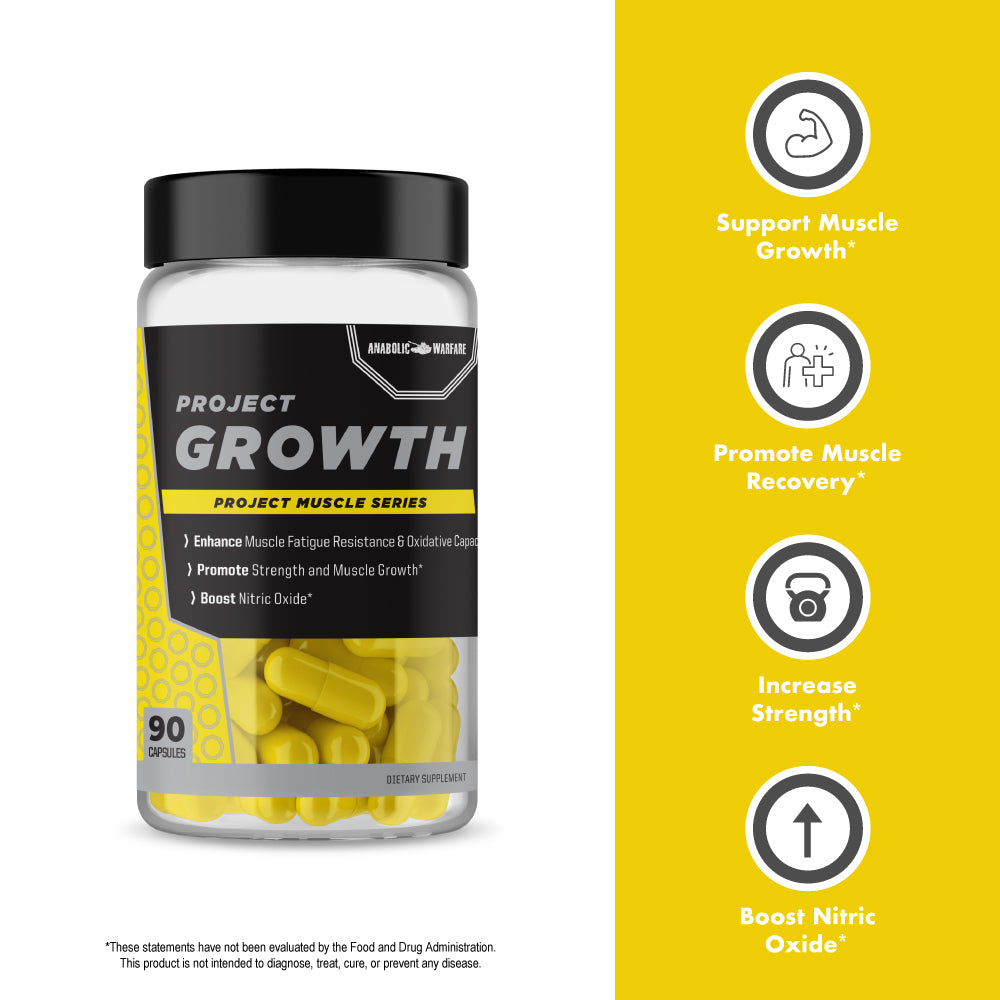
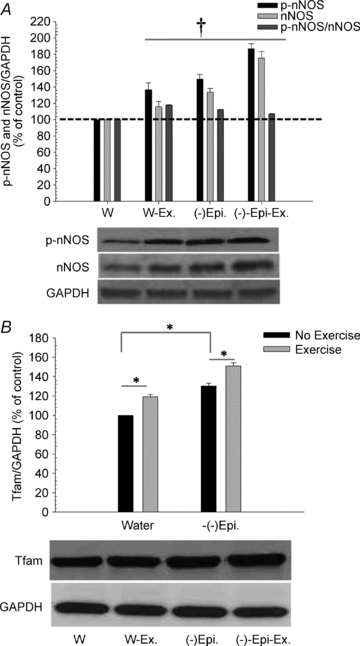
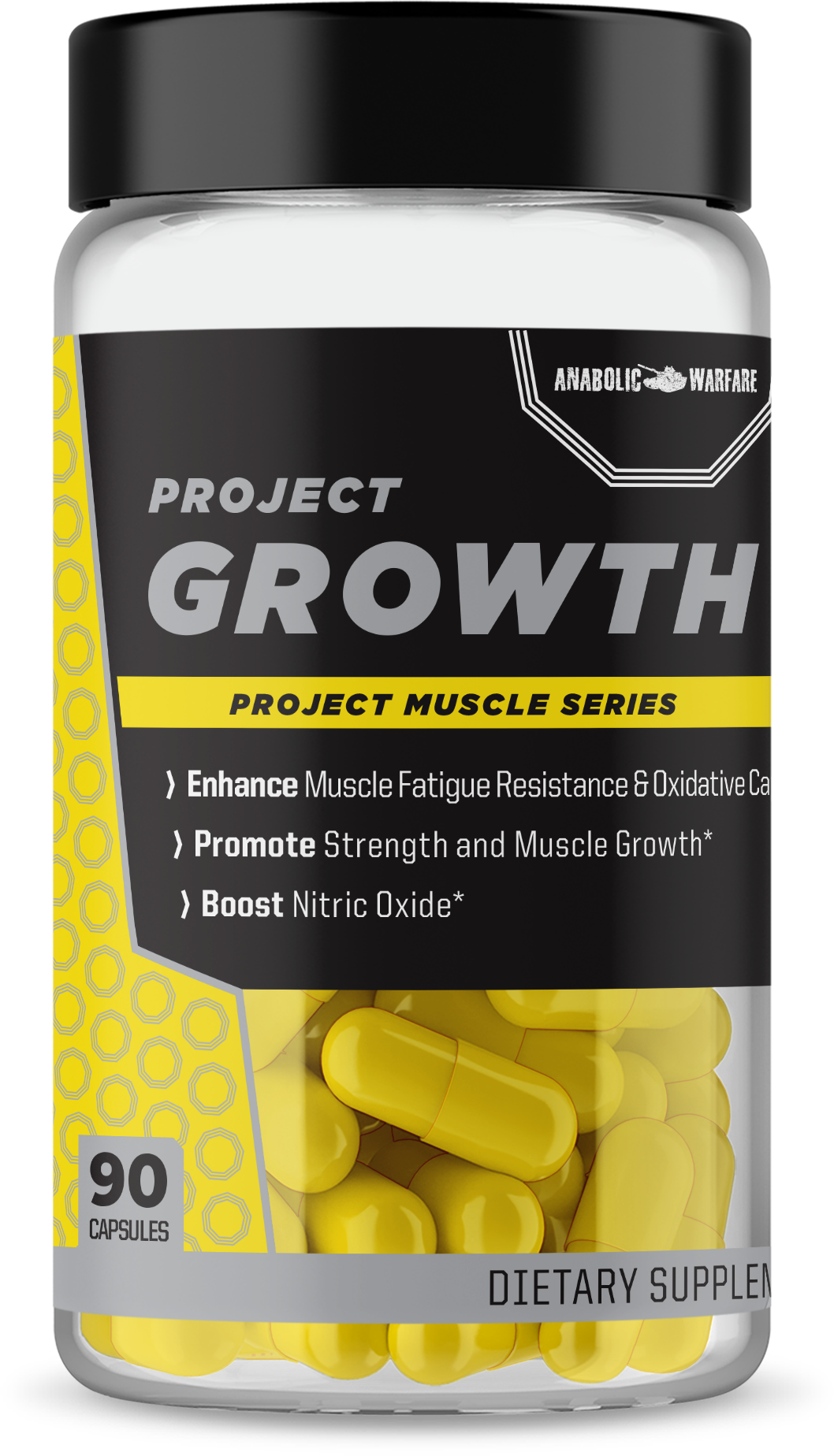
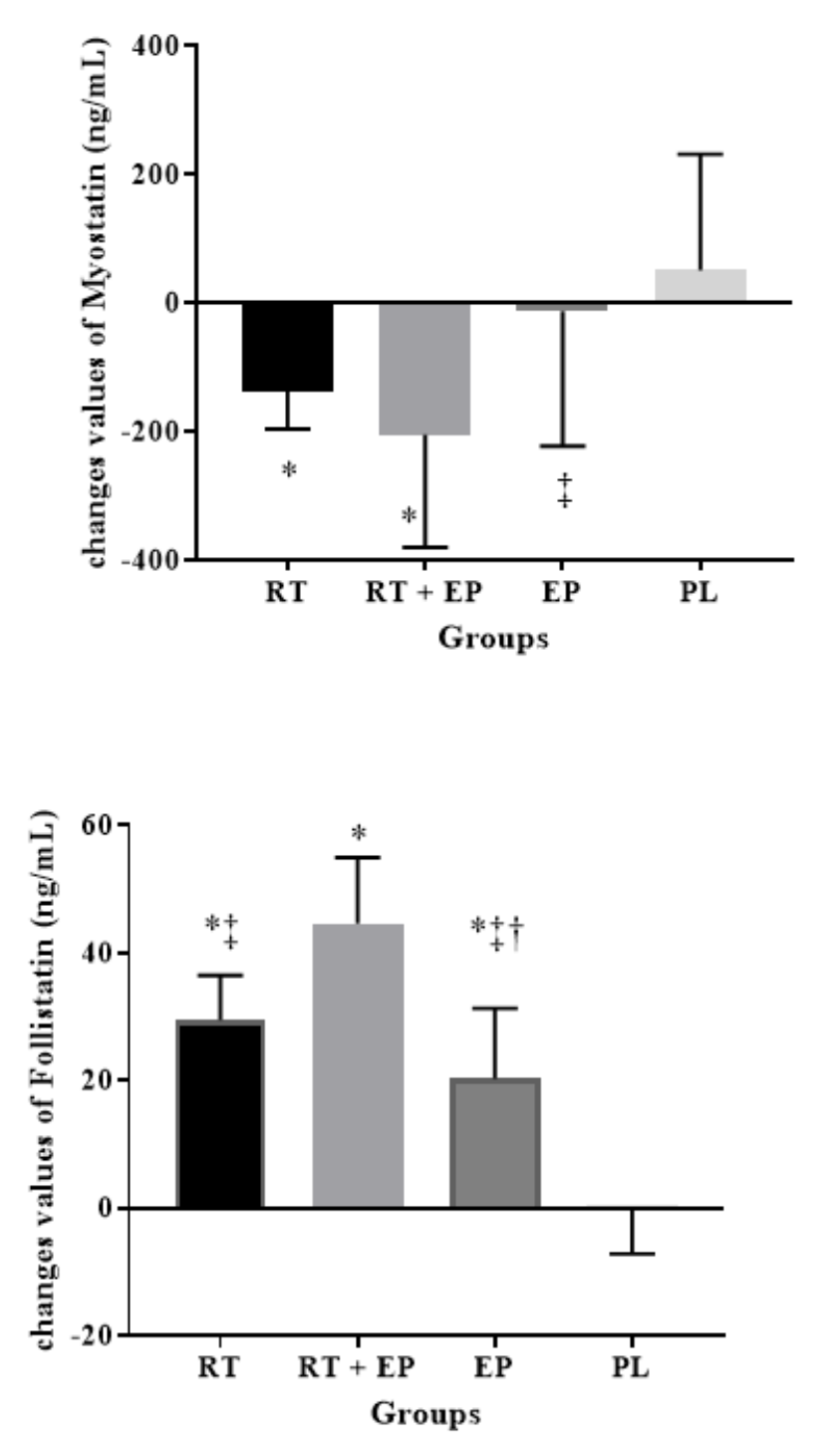
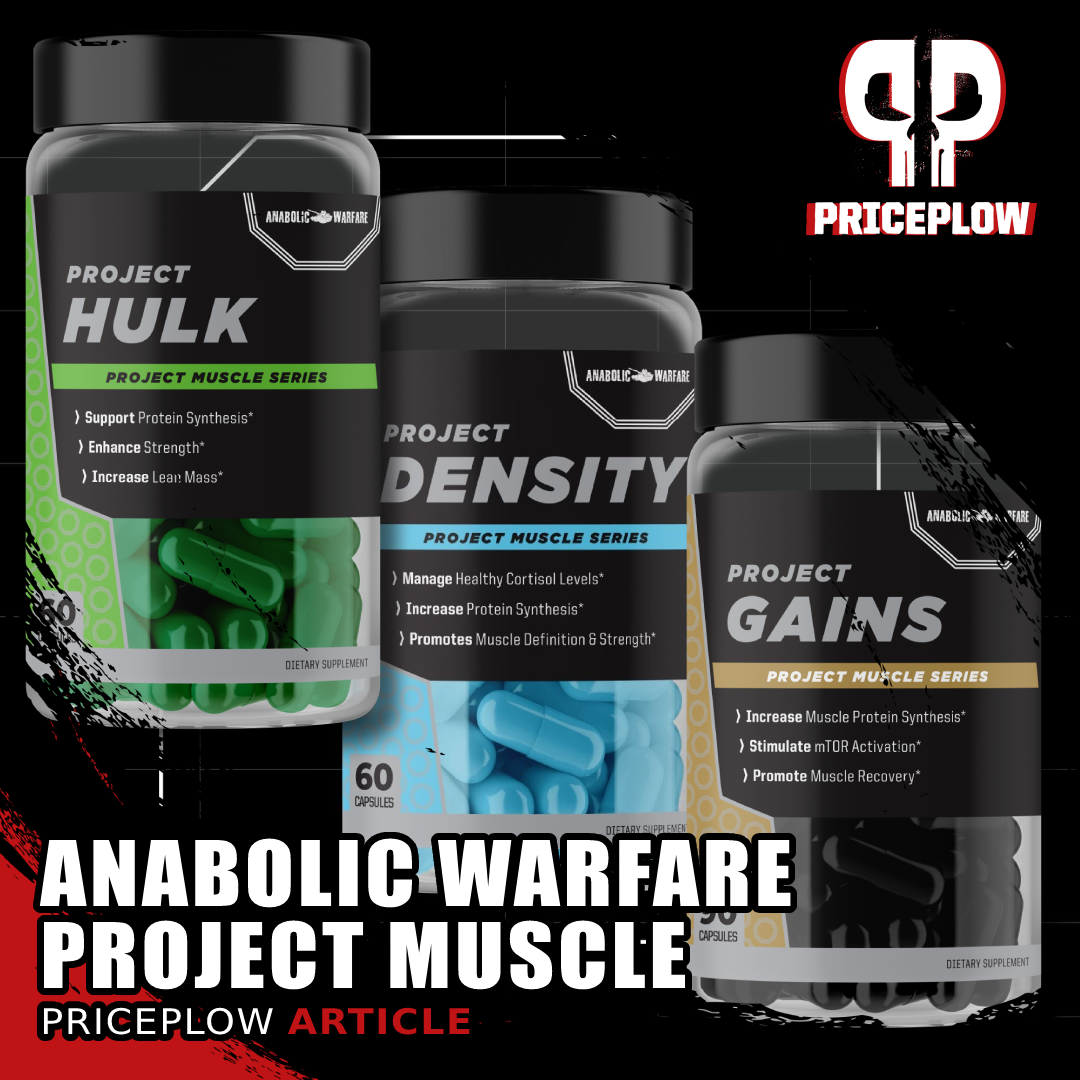
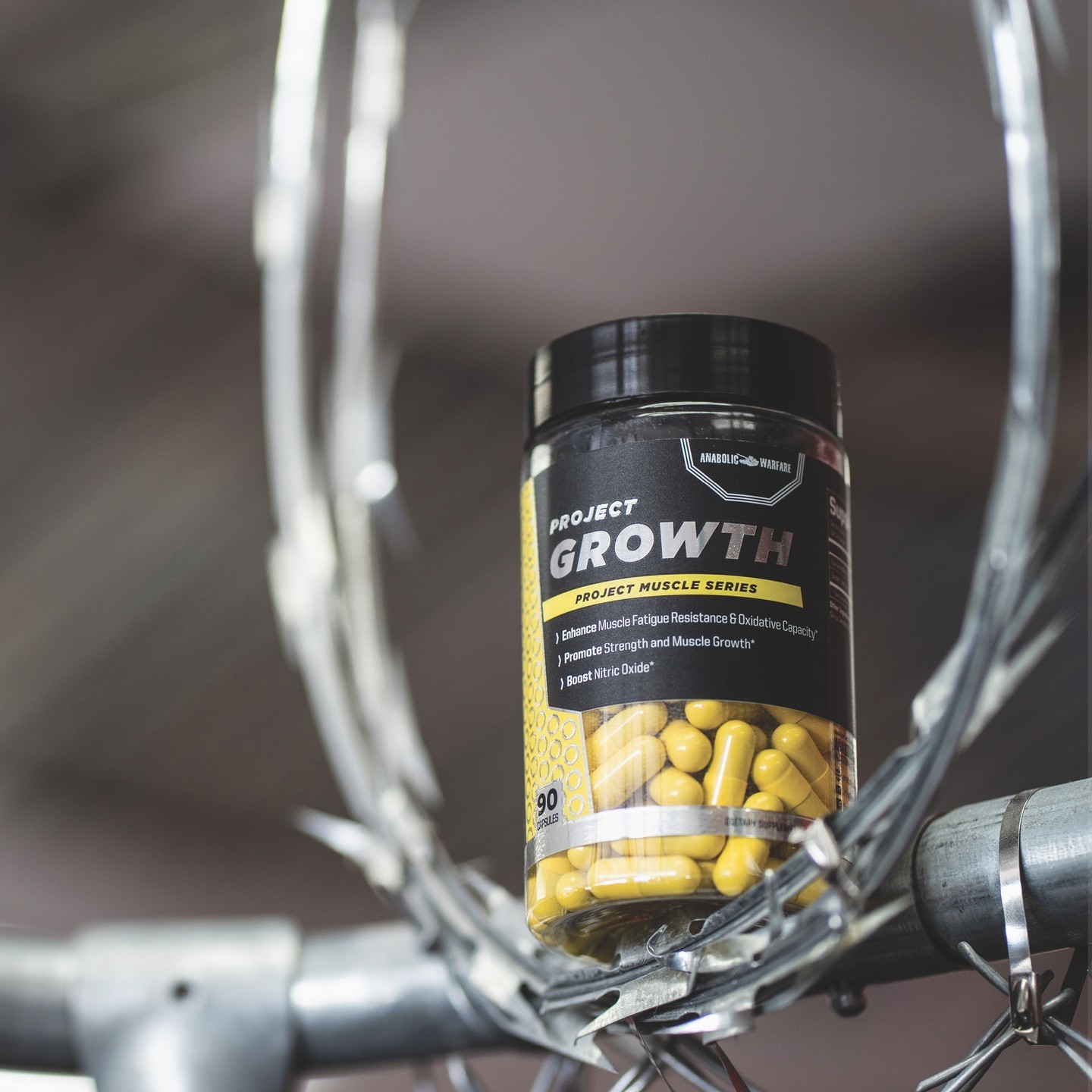

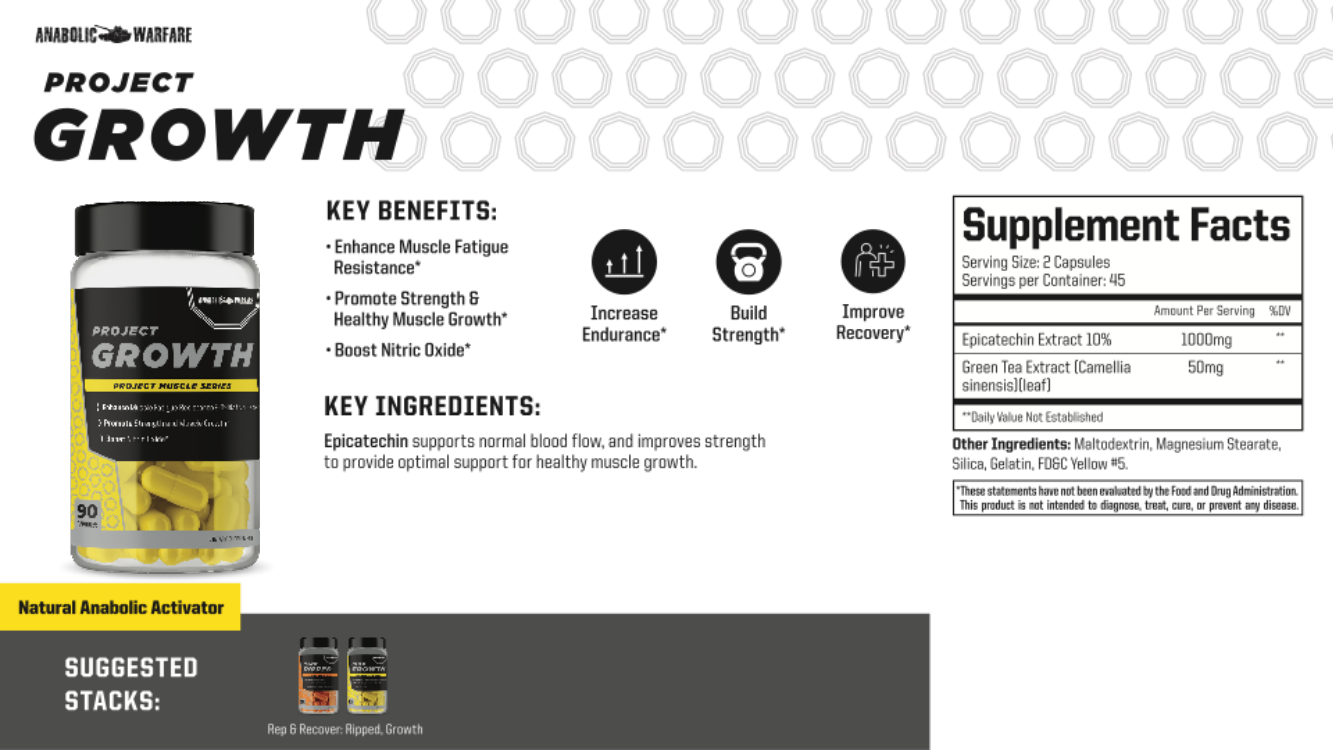


Comments and Discussion (Powered by the PricePlow Forum)